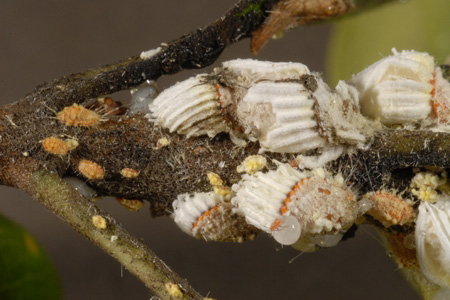Home » Bugs » Lawn Pests »
Active Seasons




Cottony Cushion Scale Appearance and Size Facts
Feeding on plants across south Florida, homeowners and business owners alike have struggled to deal with cottony cushion scale infestations. Whether it’s in a houseplant or a tree or bush outside, it feels as if an infestation is unstoppable. However, with the right information presented by Hulett Environmental Services, you can gain the knowledge and tools needed to identify and control cottony cushion scales around your Florida home.
Some standard characteristics of cottony cushion scales include:
- Shape: Cylindrical shape with outer wax covering
- Size: Approximately 1/4 to 1/2 of an inch in length without egg sacs
- Color: Dark red bodies with dark-colored antennae
- Wings: Wings are present in males and females, but males are rare overall
Distinguishing Cottony Cushion Scales From Other Lawn Pests
Cottony cushion scales are most commonly found with their white and waxy outer covering, which is more prominent than in other lawn pests. Unfortunately, with their small size, identification can be a tough task to accomplish on your own. There’s no shame in turning to professional pest control for help identifying your potential cottony cushion scale problem.
We provide treatment for cottony cushion scales in the following locations and their surrounding areas:

Behavior and Habitat of Cottony Cushion Scales
One characteristic of cottony cushion scales that makes them unique is that they are hermaphroditic, meaning they contain both male and female reproductive organs. Although males are documented, they are known to be rare. In fact, if a hermaphroditic female reproduces with a male, their offspring can be a mixture of hermaphroditic females and males.
The average life span of a cottony cushion scale is around two months, with two generations occurring each year. Early stages, such as nymphs, feed on foliage and smaller leaves and branches before moving to larger leaves and branches in adulthood. With such a rapid reproduction rate and the ability to survive on foliage, controlling them can become a near-impossible task to tackle alone.

Signs of Infestation of Cottony Cushion Scales
Leaf drop and defoliation is a critical indicator that you might have an infestation of cottony cushion scales. You could also find mold in foliage, twigs, branches, and trunks. They also have the ability to attract other pests, such as ants. If there’s an increase of ants in your Florida home, there’s a good chance they aren’t alone.

Tips for Prevention of Cottony Cushion Scales
Remove any spare foliage and branches from your home, as these are attractants for cottony cushion scales. Preventative and recurring maintenance programs from a professional pest and lawn company is the best way to help prevent a scale infestation from occurring.
Getting Rid of Cottony Cushion Scales
If you already have an infestation, don’t worry, the pros can help. If you need the most effective cottony cushion scale removal for your Florida home, go to professional pest control services, such as the ones offered by Hulett Environmental Services. You can reap the benefits of pest control for residential and commercial purposes.
Effective Cottony Cushion Scale Control Solutions
Remove cottony cushion scales from your south Florida home by just calling Hulett. Our technicians offer effective and preventive treatments against cottony cushion scales. To get our cottony cushion scale removal services, give us a call or schedule your free inspection online today!

